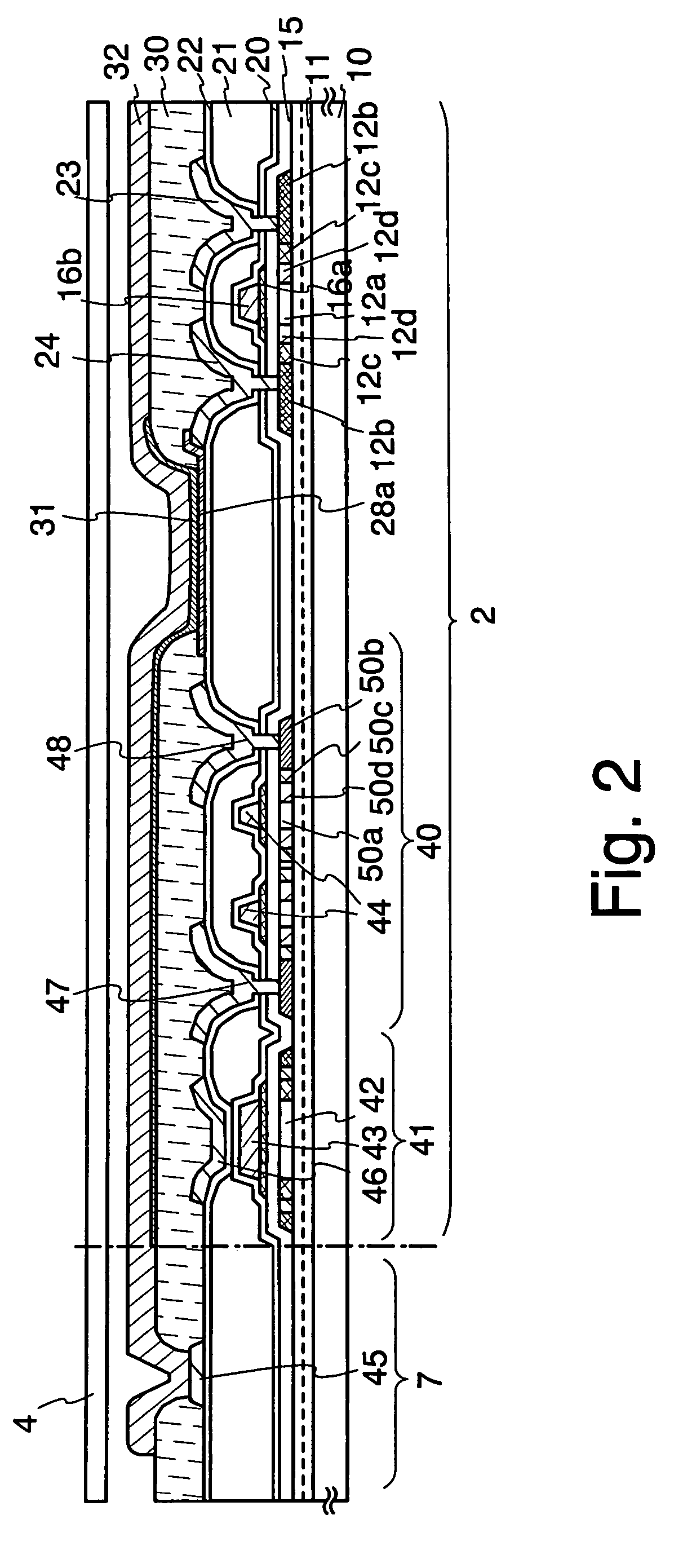Light emitting device and method for manufacturing the same
- Summary
- Abstract
- Description
- Claims
- Application Information
AI Technical Summary
Benefits of technology
Problems solved by technology
Method used
Image
Examples
example 1
[0138]Here, a method of simultaneously manufacturing a pixel portion, and TFTs (n-channel TFTs and a p-channel TFT) of a driving circuit provided in the periphery of the pixel portion on the same substrate to manufacture the light emitting device having EL element is described in detail using FIGS. 1B and 2.
[0139]For a lower layer of a base insulating film 11, a silicon oxynitride film formed from SiH4, NH3, and N2O as material gases (composition ratio: Si=32%, O=27%, N=24%, H=17%) is formed on the heat resistance glass substrate (the first substrate 10) having a thickness of 0.7 mm with a thickness of 50 nm (preferably 10 to 200 nm) and at a film deposition temperature of 400° C. by using plasma CVD. Then, after the surface is cleaned with ozone water, an oxide film on the surface is removed by means of dilute hydrofluoric acid (dilution with 1 / 100). Next, for an upper layer of the base insulating film 11, a silicon hydride oxynitride film formed from SiH4 and N2O as material gases...
example 2
[0197]In Example 1, there was described an example in which the interlayer insulation film having the curved surface on its upper end portion and the insulating material were formed. In this example, another example which is different from Example 1 is shown in FIGS. 4A and 4B. In FIGS. 4A and FIG. 4B, the same structural components as those of FIG. 1B are represented by the same reference numerals.
[0198]In the present example, there is shown an example in which, after the formation of an interlayer insulation film, a contact hole is formed by etching using the same mask.
[0199]At first, according to Example 1, the process proceeds up to the formation of an interlayer insulation film 20, followed by hydrogenation. After that, as shown in FIG. 4A, an interlayer insulation film 321 is formed using an organic material such as polyimide, acrylate, polyamide, polyimide amide, resist, or benzocyclobutene or an inorganic material such as silicon oxide, silicon nitride, or silicon oxynitride...
example 3
[0203]In this example, as shown in FIG. 6A, the sequence of forming the first electrode, the contact hole, and the connecting electrode is different from that of Example 1. The structure shown in FIG. 6A is provided for illustrating the process by which a CMP processing for flattening the first electrode can be easily performed. However, at the time of patterning for forming a connecting electrode in contact with the first electrode, etching or washing may be preferably performed such that the remainder of etching is prevented from being remained on the first electrode. For simplification, only a point different from Example 1 will be described. Here, in FIG. 6A, the same structural components as those of FIG. 1B are represented by the same reference numerals.
[0204]At first, according to Example 1, a contact hole is formed in each of interlayer insulation films 20, 21, 22, followed by forming a first electrode 628a. Then, a connecting electrode 624 and wiring 23 to 27 are formed suc...
PUM
 Login to View More
Login to View More Abstract
Description
Claims
Application Information
 Login to View More
Login to View More - R&D
- Intellectual Property
- Life Sciences
- Materials
- Tech Scout
- Unparalleled Data Quality
- Higher Quality Content
- 60% Fewer Hallucinations
Browse by: Latest US Patents, China's latest patents, Technical Efficacy Thesaurus, Application Domain, Technology Topic, Popular Technical Reports.
© 2025 PatSnap. All rights reserved.Legal|Privacy policy|Modern Slavery Act Transparency Statement|Sitemap|About US| Contact US: help@patsnap.com



